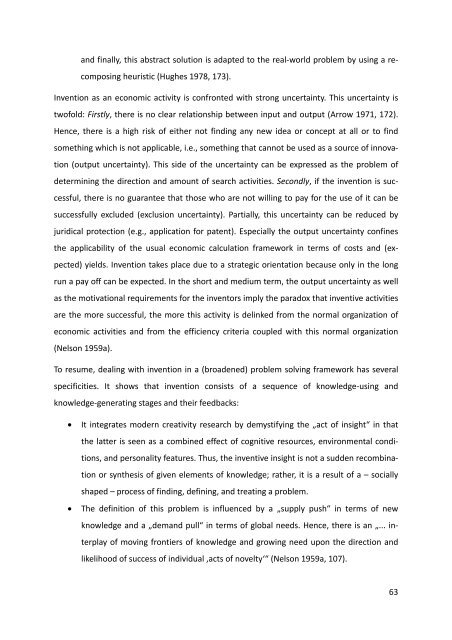Ansätze einer akteurbasierten Innovationserklärung ... - KOBRA
Ansätze einer akteurbasierten Innovationserklärung ... - KOBRA
Ansätze einer akteurbasierten Innovationserklärung ... - KOBRA
You also want an ePaper? Increase the reach of your titles
YUMPU automatically turns print PDFs into web optimized ePapers that Google loves.
and finally, this abstract solution is adapted to the real‐world problem by using a recomposing<br />
heuristic (Hughes 1978, 173).<br />
Invention as an economic activity is confronted with strong uncertainty. This uncertainty is<br />
twofold: Firstly, there is no clear relationship between input and output (Arrow 1971, 172).<br />
Hence, there is a high risk of either not finding any new idea or concept at all or to find<br />
something which is not applicable, i.e., something that cannot be used as a source of innovation<br />
(output uncertainty). This side of the uncertainty can be expressed as the problem of<br />
determining the direction and amount of search activities. Secondly, if the invention is successful,<br />
there is no guarantee that those who are not willing to pay for the use of it can be<br />
successfully excluded (exclusion uncertainty). Partially, this uncertainty can be reduced by<br />
juridical protection (e.g., application for patent). Especially the output uncertainty confines<br />
the applicability of the usual economic calculation framework in terms of costs and (expected)<br />
yields. Invention takes place due to a strategic orientation because only in the long<br />
run a pay off can be expected. In the short and medium term, the output uncertainty as well<br />
as the motivational requirements for the inventors imply the paradox that inventive activities<br />
are the more successful, the more this activity is delinked from the normal organization of<br />
economic activities and from the efficiency criteria coupled with this normal organization<br />
(Nelson 1959a).<br />
To resume, dealing with invention in a (broadened) problem solving framework has several<br />
specificities. It shows that invention consists of a sequence of knowledge‐using and<br />
knowledge‐generating stages and their feedbacks:<br />
<br />
<br />
It integrates modern creativity research by demystifying the „act of insight“ in that<br />
the latter is seen as a combined effect of cognitive resources, environmental conditions,<br />
and personality features. Thus, the inventive insight is not a sudden recombination<br />
or synthesis of given elements of knowledge; rather, it is a result of a – socially<br />
shaped – process of finding, defining, and treating a problem.<br />
The definition of this problem is influenced by a „supply push“ in terms of new<br />
knowledge and a „demand pull“ in terms of global needs. Hence, there is an „... interplay<br />
of moving frontiers of knowledge and growing need upon the direction and<br />
likelihood of success of individual ,acts of novelty‘“ (Nelson 1959a, 107).<br />
63















